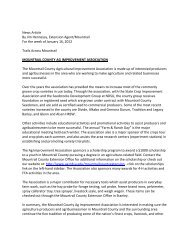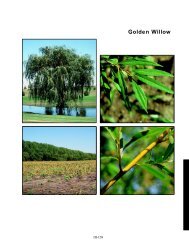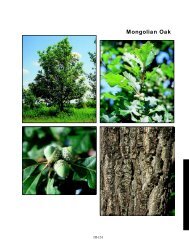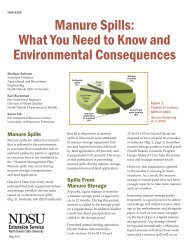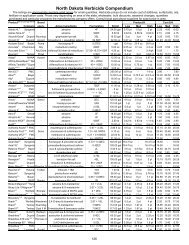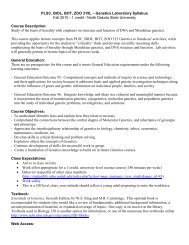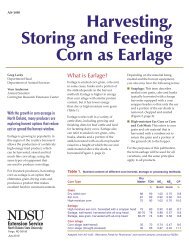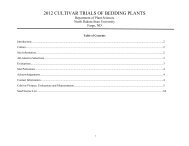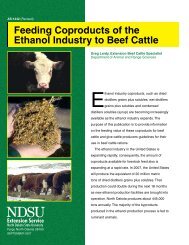NDSU Beef Feedlot - NDSU Agriculture - North Dakota State ...
NDSU Beef Feedlot - NDSU Agriculture - North Dakota State ...
NDSU Beef Feedlot - NDSU Agriculture - North Dakota State ...
You also want an ePaper? Increase the reach of your titles
YUMPU automatically turns print PDFs into web optimized ePapers that Google loves.
Effect of Distillers Grains on Natural vs. Conventional Supplements and<br />
Production Methods on <strong>Feedlot</strong> Performance, and Carcass<br />
Characteristics<br />
B.R. Ilse 1 , V.L. Anderson 1 , M.M. Thompson 2 , and C.S. Schauer 2<br />
1 <strong>NDSU</strong> Carrington Research Extension Center<br />
2 <strong>NDSU</strong> Hettinger Research Extension Center<br />
Abstract<br />
This trial was initiated to determine the effects of natural production methods for beef cattle during the<br />
finishing period versus conventional management in diets containing 20 percent modified distillers<br />
grains with solubles (MDGS). Seventy-two backgrounded steers were assigned to one of two<br />
treatments: 1) conventionally (CON) managed calves received growth promotants (implants/<br />
ionophores) and antibiotics if required and 2) natural (NAT) calves were not given growth promotants or<br />
antibiotics. In place of the ionophore in the natural diet, a supplement comprised of a commerciallyproduced,<br />
live yeast, Saccharomyces cerevisiae, was included in the totally-mixed ration. Overall the<br />
steers managed and fed conventionally consumed more feed, were heavier and had greater average<br />
daily gains compared to naturally-managed calves (P < 0.0001). Efficiency overall for pounds of feed/<br />
pound of gain was significantly different due to treatment (P = 0.02) and hot carcass weight, REA, and<br />
KPH were all significantly affected (P < 0.04) by treatment. Backfat was not affected by treatment (P =<br />
0.48). Yield grade was not significantly different due to treatment (P = 0.53). However, NAT steers had<br />
higher marbling score (P = 0.02).<br />
Introduction<br />
Growth in the ethanol industry has increased the amount of distillers grains available for feed. Natural<br />
beef production has become of interest and demand. Natural beef, which must meet the criteria of<br />
―never-ever‖ receiving implants, ionophore or antibiotics, and reasonably priced ethanol byproducts<br />
could allow <strong>North</strong> <strong>Dakota</strong>’s cattlemen to create a natural cattle feeding industry within the state.<br />
Materials and Methods<br />
Seventy-two black Angus steers were backgrounded at the Hettinger Research Extension Center and<br />
shipped to the Carrington Research Extension Center for finishing. Upon arrival at Carrington, the<br />
steers were allotted in one of two production management treatments: natural (NAT) in which the steers<br />
received no implants, antibiotics or ionophores, or conventional (CON) in which the steers were<br />
managed receiving all common conventional finishing practices. Finishing diets (65 Mcal/lb.) were<br />
formulated to meet or exceed NRC (1996) nutritional beef cattle recommendations (Table 1).<br />
Page 41 2009 <strong>NDSU</strong> <strong>Beef</strong> <strong>Feedlot</strong> Research Report<br />
Steers fed the finishing diet<br />
including 20% MDGS with natural<br />
or conventional supplement.



